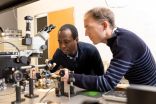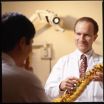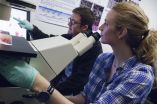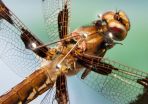(Press-News.org) Treating the potentially blinding haze of a scar on the cornea might be as straightforward as growing stem cells from a tiny biopsy of the patient's undamaged eye and then placing them on the injury site, according to mouse model experiments conducted by researchers at the University of Pittsburgh School of Medicine. The findings, published today in Science Translational Medicine, could one day rescue vision for millions of people worldwide and decrease the need for corneal transplants.
According to the National Eye Institute, part of the National Institutes of Heath, "Worldwide, corneal infectious diseases have compromised the vision of more than 250 million people and have blinded over 6 million of them." Trauma, such as burns, are also a leading cause of corneal scarring, said senior investigator James L. Funderburgh, Ph.D., professor of ophthalmology at Pitt and associate director of the Louis J. Fox Center for Vision Restoration of UPMC and the University of Pittsburgh, a joint program of UPMC Eye Center and the McGowan Institute for Regenerative Medicine.
"The cornea is a living window to the world, and damage to it lead to cloudiness or haziness that makes it hard or impossible to see," Dr. Funderburgh said. "The body usually responds to corneal injuries by making scar tissue. We found that delivery of stem cells initiates regeneration of healthy corneal tissue rather than scar leaving a clear, smooth surface."
Study lead author Sayan Basu, MBBS, MS, a corneal surgeon working at the L.V. Prasad Eye Institute in Hyderabad, India, joined Dr. Funderburgh's lab in Pittsburgh. Dr. Basu had previously developed a technique to obtain ocular stem cells from tiny biopsies at the surface of the eye and a region between the cornea and sclera known as the limbus. Removal of tissue from this region heals rapidly with little discomfort and no disruption of vision. After collecting biopsies from banked human donor eyes, the team expanded the numbers of cells in a culture plate using human serum to nourish them. They conducted several tests to verify that they these cells were, in fact, corneal stem cells.
"Using the patient's own cells from the uninjured eye for this process could let us bypass rejection concerns," Dr. Basu noted. "That could be very helpful, particularly in places that don't have corneal tissue banks for transplant."
The team then tested the human stem cells in a mouse model of corneal injury. They used a gel of fibrin, a protein found in blood clots that is commonly used as a surgical adhesive, to glue the cells to the injury site. They found the scarred corneas of mice healed and became clear again within four weeks of treatment, while those of untreated mice remained clouded.
"Even at the microscopic level, we couldn't tell the difference between the tissues that were treated with stem cells and undamaged cornea," Dr. Funderburgh said.
"We were also excited to see that the stem cells appeared to induce healing beyond the immediate vicinity of where they were placed. That suggests the cells are producing factors that promote regeneration, not just replacing lost tissue."
His team's work is the inspiration behind a small pilot study underway in Hyderabad in which a handful of patients will receive their own corneal stem cells as a treatment.
INFORMATION:
The team includes co-lead author Andrew J. Hertsenberg, B.S., Martha L. Funderburgh, M.S.P.H, Michael K. Burrow, B.S., Mary M. Mann, M.S., Yiqin Du, M.D., Ph.D., Kira L. Lathrop, M.A.M.S., and Fatima N. Syed-Picard, Ph.D., all of Pitt; and Sheila M. Adams, Ph.D., and David E. Birk, Ph.D., both of the University of South Florida.
The project was funded by NIH grants EY016415, EY05129 and P30-EY08098, the Louis J. Fox Center for Vision Restoration, the Hyderabad Eye Research Foundation and from Research to Prevent Blindness Inc.
About the University of Pittsburgh School of Medicine
As one of the nation's leading academic centers for biomedical research, the University of Pittsburgh School of Medicine integrates advanced technology with basic science across a broad range of disciplines in a continuous quest to harness the power of new knowledge and improve the human condition. Driven mainly by the School of Medicine and its affiliates, Pitt has ranked among the top 10 recipients of funding from the National Institutes of Health since 1998. In rankings recently released by the National Science Foundation, Pitt ranked fifth among all American universities in total federal science and engineering research and development support.
Likewise, the School of Medicine is equally committed to advancing the quality and strength of its medical and graduate education programs, for which it is recognized as an innovative leader, and to training highly skilled, compassionate clinicians and creative scientists well-equipped to engage in world-class research. The School of Medicine is the academic partner of UPMC, which has collaborated with the University to raise the standard of medical excellence in Pittsburgh and to position health care as a driving force behind the region's economy. For more information about the School of Medicine, see
http://www.medschool.pitt.edu.
Rats that received thyroid hormones had a reduced risk for dangerous heart arrhythmias following a heart attack, according to a new study by a team of medical researchers at New York Institute of Technology.
In the NIH-funded study, published in the Journal of Cardiac Failure, the team found that thyroid hormone replacement therapy significantly reduced the incidence of atrial fibrillation - a specific kind of irregular heartbeat, or arrhythmia -- in the rats, compared to a control group that did not receive the hormones.
The finding could have important implications ...
San Diego, Calif., Dec. 10, 2014 -- Engineers at the University of California, San Diego have demonstrated a new and more efficient way to trap light, using a phenomenon called bound states in the continuum (BIC) that was first proposed in the early days of quantum wave mechanics.
Boubacar Kanté, an assistant professor in electrical and computer engineering at UC San Diego Jacobs School of Engineering, and his postdoctoral researcher Thomas Lepetit described their BIC experiment online in the rapid communication section of journal Physical Review B. The study directly ...
Researchers from North Carolina State University and Qatar University have developed a new "high-entropy" metal alloy that has a higher strength-to-weight ratio than any other existing metal material.
High-entropy alloys are materials that consist of five or more metals in approximately equal amounts. These alloys are currently the focus of significant attention in materials science and engineering because they can have desirable properties.
The NC State research team combined lithium, magnesium, titanium, aluminum and scandium to make a nanocrystalline high-entropy ...
Is it the thought that really counts?
When it comes to giving gift cards, maybe not.
New research from the University of Cincinnati can help even the most thoughtful gift giver avoid the mistake of over-personalization and keep that card from being banished to the bottom of a purse or hidden deep inside a wallet for the next six months.
"Givers often fail to anticipate that the gifts they prefer to give are not necessarily the ones recipients prefer to receive," says Mary Steffel, researcher and assistant professor of marketing in UC's Carl H. Lindner College of Business.
So ...
CORVALLIS, Ore. - Researchers for the first time have developed a method to track through the human body the movement of polycyclic aromatic hydrocarbons, or PAHs, as extraordinarily tiny amounts of these potential carcinogens are biologically processed and eliminated.
PAHs, which are the product of the incomplete combustion of carbon, have been a part of everyday human life since cave dwellers first roasted meat on an open fire. More sophisticated forms of exposure now range from smoked cheese to automobile air pollution, cigarettes, a ham sandwich and public drinking ...
Many children who sustain so-called open bone fractures in the forearm or lower leg can, and do, heal safely without surgery, according to the results of a small study led by investigators at the Johns Hopkins Children's Center.
Open fractures occur when the broken bone protrudes through the skin, causing a puncture wound.
The study, published ahead of print in the Journal of Children's Orthopaedics, shows that when the wound is small -- less ½-inch in diameter -- and the surrounding tissue is free of visible contamination with dirt or debris, children heal well ...
CAMBRIDGE, MA, December 10, 2014 - A team of investigators from the Broad Institute, Massachusetts General Hospital and other leading biomedical research institutions has pinpointed rare mutations in a gene called APOA5 that increase a person's risk of having a heart attack early in life. These mutations disable the APOA5 gene and also raise the levels in the blood of triglyceride-rich lipoproteins, a type of fat. The researchers' findings, together with other recent genetic discoveries -- specifically, the identification of protective mutations in the APOC3 gene that lower ...
Stem cells in early embryos have unlimited potential; they can become any type of cell, and researchers hope to one day harness this rejuvenating power to heal disease and injury. To do so, they must, among other things, figure out how to reliably arrest stem cells in a Peter Pan-like state of indefinite youth and potential. It's clear the right environment can help accomplish this, acting as a sort of Neverland for stem cells. Only now are scientists beginning to understand how.
New collaborative research between scientists at Rockefeller University and Memorial ...
The dragonfly is a swift and efficient hunter. Once it spots its prey, it takes about half a second to swoop beneath an unsuspecting insect and snatch it from the air. Scientists at the Howard Hughes Medical Institute's Janelia Research Campus have used motion-capture techniques to track the details of that chase, and found that a dragonfly's movement is guided by internal models of its own body and the anticipated movement of its prey. Similar internal models are used to guide behavior in humans.
"This highlights the role that internal models play in letting these creatures ...
INDIANAPOLIS -- How do some proteins survive the extreme heat generated when they catalyze reactions that can happen as many as a million times per second? Work by researchers from Indiana University-Purdue University Indianapolis (IUPUI) and the University of California Berkeley published online on Dec. 10 in Nature provides an explosive answer to this important question.
Proteins are essential to the human body, doing the bulk of the work within cells. Proteins are large molecules responsible for the structure, function, and regulation of tissues and organs. Enzymes ...






